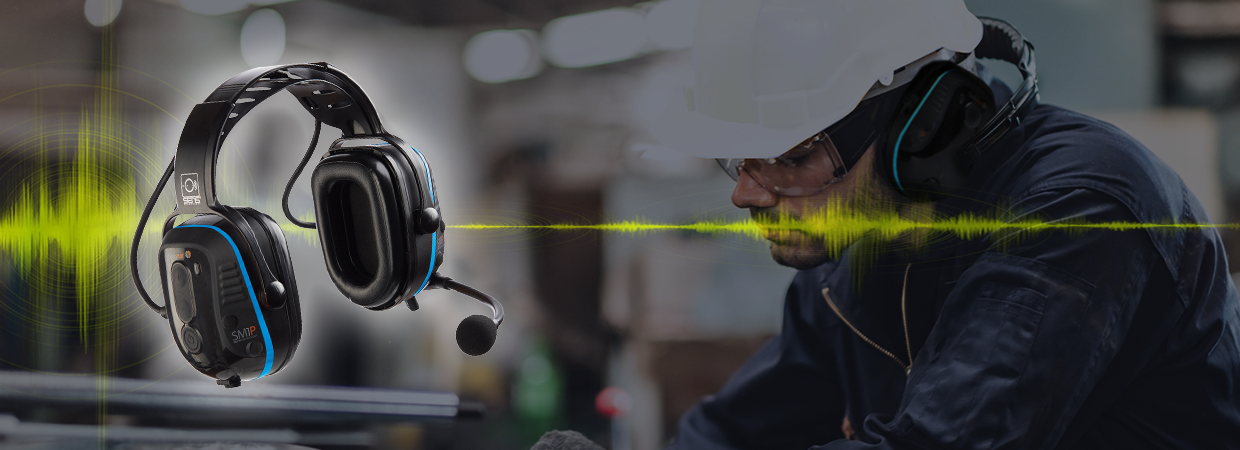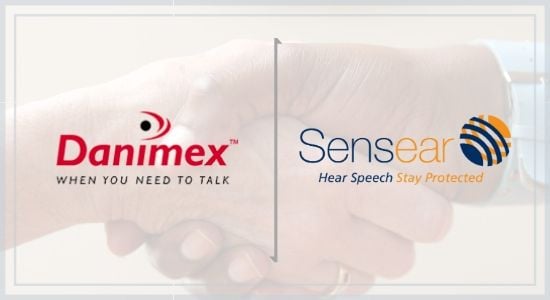- Home
- Blog
- Hearing Protection for Workers
- Breaking the Stigma: The Importance of Hearing Protection in the Workplace

Breaking the Stigma: The Importance of Hearing Protection in the Workplace
Hearing loss isn’t just an inconvenience—it’s a silent threat that affects not just the individual who suffers from it, but everyone around them. Whether it’s the construction worker on a noisy job site, the factory worker surrounded by loud machinery, or the professional who enjoys listening to music at high volumes, the impact of noise-induced hearing loss (NIHL) can be devastating. However, the stigma surrounding hearing protection—whether from an outdated sense of 'macho' bravado, discomfort with the technology, or the feeling that one should simply acclimate to the environment—keeps many from adopting effective solutions. At Sensear, we’re here to break that stigma and encourage people to take proactive steps in protecting their hearing, before it’s too late.
The Impact of Not Wearing Hearing Protection
While hearing loss is irreversible, it is also completely preventable. The effects of neglecting to protect your hearing may not be immediately obvious, but over time, they accumulate, leading to both physical and emotional consequences. In fact, hearing loss due to high noise exposure is one of the most common work-related illnesses in the United States, costing businesses around $242 million annually in workers' compensation, according to the Centers for Disease Control and Prevention (CDC).
Noise-induced hearing loss doesn’t just affect the individual’s ability to hear, it impacts their entire well-being. People with untreated hearing loss can experience decreased productivity, as they may struggle to hear safety signals, engage in clear communication, and make effective decisions in critical situations. They may also face mental health challenges, such as stress, cognitive decline, and even isolation, as social interactions become more difficult.
The Social and Cognitive Costs of Hearing Loss
Hearing loss goes beyond physical impairment—it directly impacts social interactions and cognitive function. For example, the inability to hear a colleague’s warnings about potential dangers or not being able to communicate clearly with team members could lead to accidents or even fatalities in the workplace. Moreover, when individuals are unable to fully participate in conversations or socialize with their peers, they may feel isolated and disconnected, which can further affect mental health and overall quality of life.
Furthermore, cognitive thinking and concentration can be severely impacted. The brain is constantly working to process sounds, and when the brain can’t make sense of the noise, it becomes more fatigued and less effective. This can lead to a vicious cycle: the more fatigued someone becomes from mental strain, the more likely they are to make mistakes or overlook important details, which can negatively affect both their health and the safety of those around them.
Generational Differences in Hearing Protection Adoption
A critical factor in the failure to adopt proper hearing protection can be the stigmas associated with wearing it. For younger generations, the adoption of hearing protection is often linked to their exposure to the gaming world, where noise levels are high, and technology is readily available. Gamers, who have been raised with headphones and advanced communication technology, are often more comfortable with the idea of protecting their hearing. For them, wearing high-quality headphones is not just a necessity—it’s an integral part of their lifestyle.
In contrast, older generations may be more hesitant to embrace hearing protection. For many, it’s associated with discomfort or simply not “cool” or “macho.” Workers who have spent decades in noisy environments without facing immediate consequences may feel they can continue without protection, believing that hearing loss is something they’ll deal with later in life, or that they’ve simply acclimated to the surroundings. Over time, they may come to think that the constant noise is just part of their daily routine, and that they've grown accustomed to it—desensitized to its potential impact on their hearing. Unfortunately, this is not the case. Hearing loss is already occurring at earlier ages than ever before. Twenty years ago, the average age for hearing loss was in the 70s; today, it’s between 60 and 62.
This generational gap in hearing protection adoption isn’t just a matter of discomfort—it's about education. Younger generations are more likely to see the value in hearing protection because they are taught to value their health and long-term well-being. Older generations, on the other hand, may not have received that same education or been provided with hearing protection options that are comfortable and effective.
Breaking the Intimidation Factor: Why One Naysayer Can Impact the Whole Team
On job sites, peer pressure plays a major role in how safety practices are adopted. If one worker dismisses the importance of wearing hearing protection, it can have a ripple effect on others. The attitude of a single naysayer can be enough to influence their peers, especially if they hold a leadership role or are seen as experienced and knowledgeable. This creates a dangerous cycle, where workers may feel intimidated or even ashamed to wear hearing protection, thinking it may be perceived as a sign of weakness or lack of toughness.
This culture of intimidation can undermine efforts to protect workers’ hearing and, more importantly, jeopardize their safety. The danger is not only in the physical hearing loss but in the chain reaction that can occur when one person’s decision to forgo protection negatively impacts others. Just as one worker can influence the adoption of hearing protection, they can also influence whether safety signals are heard, conversations are understood, and critical decisions are made accurately.
The Role of Employers: Leading by Example
Employers play a crucial role in breaking these stigmas and fostering a culture of hearing protection. The first step is making high-quality hearing protection readily available and encouraging its use. That’s where Sensear comes in—we provide cutting-edge, comfortable, and highly effective hearing protection solutions that don’t sacrifice situational awareness. Our products, equipped with Active Noise Control technology, allow workers to stay aware of their surroundings while ensuring clear communication in even the noisiest environments.
The ability to hear speech clearly, even in high-noise environments, is crucial to maintaining workplace safety. Employers should also take a proactive role in educating their employees about the risks of hearing loss and the benefits of adopting hearing protection. This education should extend beyond simply issuing earplugs or earmuffs. It should include discussions about why hearing protection is necessary, how it improves communication and safety, and the long-term impact of neglecting it.
Why You Should Take Action Now
The statistics speak for themselves: Over 30 million U.S. workers are exposed to noise levels high enough to cause irreversible hearing loss, according to the National Institute of Occupational Safety and Health (NIOSH). What’s even more concerning is that these numbers reflect only reported cases—many workers suffer hearing loss without realizing it. The sad truth is that most people don’t fully recognize the extent of the damage until it’s too late.
However, the good news is that hearing loss is preventable. With the right hearing protection and noise management practices, you can avoid becoming part of this statistic. Proactive steps like early testing, using advanced hearing protection technology, and prioritizing safe listening practices can help ensure that your hearing—and your health—are protected for a lifetime.
Sensear: Protecting Your Hearing, Protecting Your Future
At Sensear, we are dedicated to driving a new approach to hearing protection. Our communication systems integrate the best hearing protection technology, providing workers with not only the peace of mind that their hearing is safeguarded, but also the ability to stay connected and aware of their environment. Our products ensure 360º situational awareness, allowing for face-to-face communication and seamless integration of short and long-range connectivity.
By choosing Sensear’s total hearing protection and communication solutions, you are investing in your future. Don’t be a statistic—take control of your hearing health today. Be proactive, educate yourself, and choose the best hearing protection solutions available. Your hearing loss affects everyone around you, but together, we can change the culture around hearing protection and make workplaces safer for all.
Hearing Loss Across Generations: How Young Adults, Middle-Aged Workers, and Older Adults Are Affected
Hearing loss is a condition that doesn’t discriminate based on age, but its causes and prevalence vary significantly across different generations. For young adults, exposure to loud music and events is a growing concern, while middle-aged workers face the risks of occupational noise. Meanwhile, older adults often contend with age-related hearing loss that gradually diminishes their ability to hear. Understanding how hearing loss impacts each generation is crucial for implementing preventative measures and ensuring that people at every stage of life prioritize their auditory health.
Young Adults (Millennials and Gen Z):
The widespread use of personal listening devices among Millennials and Gen Z has contributed to a rise in hearing loss within these groups. Prolonged exposure to high-volume levels through earbuds can damage the delicate structures of the inner ear. Additionally, the popularity of concerts and loud events among these generations further exacerbates the risk, as exposure to high sound levels without appropriate hearing protection can cause irreversible auditory damage.
Middle-Aged Adults:
Among adults aged 20 to 69, the prevalence of hearing loss increases with age. Approximately 15% of American adults (37.5 million) report some trouble hearing. The risk factors for hearing loss in this group include prolonged exposure to occupational noise, recreational noise, and the natural aging process.
Older Adults (Ages 65 and Above):
Hearing loss is most prevalent among older adults. Nearly half of people older than age 75 and approximately one-third of those aged 64 to 75 have some degree of hearing loss. This age group often experiences age-related hearing loss, known as presbycusis, which affects both ears and typically involves the gradual loss of high-frequency hearing.
Understanding these generational statistics is essential for developing effective hearing loss prevention and intervention programs tailored to the unique needs of each age group. While younger generations may benefit from education on safe listening practices, older adults might require support in accessing hearing aids and other assistive technologies.
Hearing Protection and Communication Across Generations: The Impact of Headsets
Young Adults (Millennials and Gen Z)
For younger generations, headsets are a vital part of daily life, offering not only entertainment but also communication in high-noise environments. Whether it’s gaming, listening to music, or attending loud events, these groups often rely on headsets that combine advanced technology with comfort. However, many young adults are unaware of the long-term risks of noise-induced hearing loss (NIHL) due to extended exposure to high volumes. At Sensear, we understand that hearing protection isn’t just about noise isolation—it’s about maintaining full 360° situational awareness in all environments, allowing users to hear important sounds while staying protected.
- Fact: Research shows that 1.1 billion young people are at risk of hearing loss due to unsafe listening practices. With Sensear’s SENS® Technology, users can safely enjoy their audio experience without sacrificing awareness of their surroundings.
Middle-Aged Adults (Gen X and Early Millennials)
For those in the middle-aged demographic, headsets are often used in professional settings, where clear communication and effective hearing protection are paramount. This generation is more aware of the risks of hearing loss, particularly in noisy work environments. Unlike their younger counterparts, they prioritize headsets that offer both noise cancellation and speech enhancement—key features that are necessary for maintaining communication in hazardous settings.
- Fact: Studies show that around 25% of adults aged 35-54 use hearing protection while working in high-noise environments. However, comfort is a critical factor in headset adoption. Sensear’s headsets are engineered for extended wear, providing the ideal balance of protection, comfort, and situational awareness, ensuring users can communicate effectively without compromising safety.
Older Adults (Baby Boomers and Seniors)
Older generations often find it challenging to adopt new technology, including headsets, due to unfamiliarity and concerns about comfort. However, as hearing loss becomes more prevalent with age, specialized headsets designed for both hearing enhancement and protection can be life-changing. Many seniors experience age-related hearing loss (presbycusis) that can be mitigated with the right technology. Sensear’s hearing protection solutions are designed not only to prevent further hearing damage but also to enhance speech clarity for older adults, ensuring they remain connected and aware of their surroundings.
- Fact: Nearly 50% of people over age 75 suffer from some form of hearing loss. With Sensear’s advanced noise-canceling technology, users can communicate in high-noise environments while maintaining optimal hearing protection, even if they already experience some hearing degradation.








